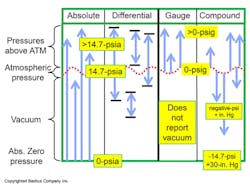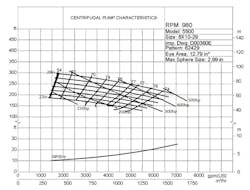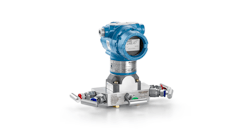The ‘Absolute’ Best Way to Monitor Your Pumping System’s Performance
Pump Guy Mailbag:
Dear Pump Guy,
You taught a pump course with our group last year in Jamaica. We were very impressed with your knowledge of pumps.
I have a question: Is the NPSHr shown on the pump curve below, in absolute or gauge pressure? And, is there a standard for pump curve using gauge and absolute pressure?
Please let us know.
Andrew B.
Reliability Engineering Department
Pump Curve
Hello Andrew,
The NPSHr on your curve is quantified in absolute terms. To my knowledge, there is no written, declared standard that NPSH must be absolute. It is understood to be absolute for at least two reasons: Reason No. 1: NPSH is an acronym meaning Net Positive Suction Head. The term is absolute by the very words that compose the acronym NPSH; Reason No. 2: NPSHr is understood to be absolute because of the nature and purpose of the NPSHr test. Let me explain.
Pumps can transport liquids, but not gases. If you want to move large volumes of a gas, you need a fan or a compressor.
Most pump companies test or rate their pumps using water as the liquid. Imperial pumps are tested and rated on water at 70 F. Metric pumps are tested and rated on water at 20 C. If the pump is tested with a different liquid, or at a different temperature, it will be stated on the pump curve.
If water converts into a gas inside the pump, either as steam (high temperature) or vapor (low pressure), the pump will not work. The NPSHr test determines the pump’s low-pressure (vacuum) limits to deal with this gas.
The NPSHr is defined as: The energy in the liquid required to avoid vaporization. It is the net positive suction energy required to avoid vaporization at the impeller eye.
For these reasons and others, the suction pressure should be reported with the gauge as close as possible to the eye of the impeller, not 8 feet away in the suction pipe. And the suction pressure gauge should be an "Absolute Gauge." A simple pressure gauge cannot report vacuum. The gauge needle will only peg "0 PSIG" at atmospheric pressure.
The reading of 0 PSIA on an absolute pressure gauge is absolute zero pressure. The pressure between 0 PSIA and 14.7 PSIA is what we call a vacuum. Vacuum is a positive number less than 14.7 PSIA. Atmospheric pressure on an absolute pressure gauge is 14.7 PSIA at sea level. We all learn in school that atmospheric pressure is 14.7 PSIA at sea level.
If there were absolutely zero molecules of matter or gas inside a vessel or sealed container, the pressure inside would be zero. If we were to assign a scale referring to this zero value, all other values above this zero reference would be positive numbers, including "vacuum."
An absolute pressure gauge reports absolute pressure. All values are positive above zero. And vacuum is a positive number less than atmospheric pressure.
As a liquid accelerates into the suction nozzle of a pump, the liquid frequently drops into vacuum as the velocity increases. A simple pressure gauge will only peg 0 PSI at atmospheric pressure and cannot record or report pressures less than atmospheric pressure. Therefore, a simple pressure gauge provides useless information (my opinion) on the suction nozzle of a pump with the liquid in vacuum.
A compound pressure gauge can report vacuum, but normally in a different and incompatible scale.
Vacuum graph
Let’s say a pump’s suction pressure is 20" of Mercury (Hg) and the discharge pressure is 50 PSIG. What is the pressure differential across this pump? If the engineer cannot answer this question without a calculator or computer, then you can bet the operators and technicians don’t know the answer either. No one is paying attention to the pumps.
Let me pose the same question and math, after converting the suction and discharge values from the previous paragraph into absolute values. Let’s say a pump’s suction pressure is 5 PSIA, and the discharge pressure is 65 PSIA. The pressure differential across the pump is 60 PSIA (65 – 5 = 60).
The Pump Guy advises: Convert your simple gauges (useless) and compound gauges (useless without a calculator) to absolute pressure gauges. You will know where your pump is operating on its performance curve, and you will know if your pump is sick or healthy.
Absolute pressure and absolute pressure gauges are best (my opinion) for your process pumps.
Regards,
Larry Bachus
The Pump Guy Seminar will be presented Jan. 12-14, 2016, in Houston, and June 7-9, 2016, in Indianapolis. For more info, visit www.flowcontrolnet work.com/pumpguy or contact Ashley Davidson at 205 995-1593, adavidson@grandviewmedia.com.
Larry Bachus, aka “The Pump Guy”
The Pump Guy is Larry Bachus, a pump consultant, lecturer, and inventor, based in Nashville, Tennessee. He’s a retired member of ASME, and lectures in both English and Spanish. You can contact him at [email protected].




